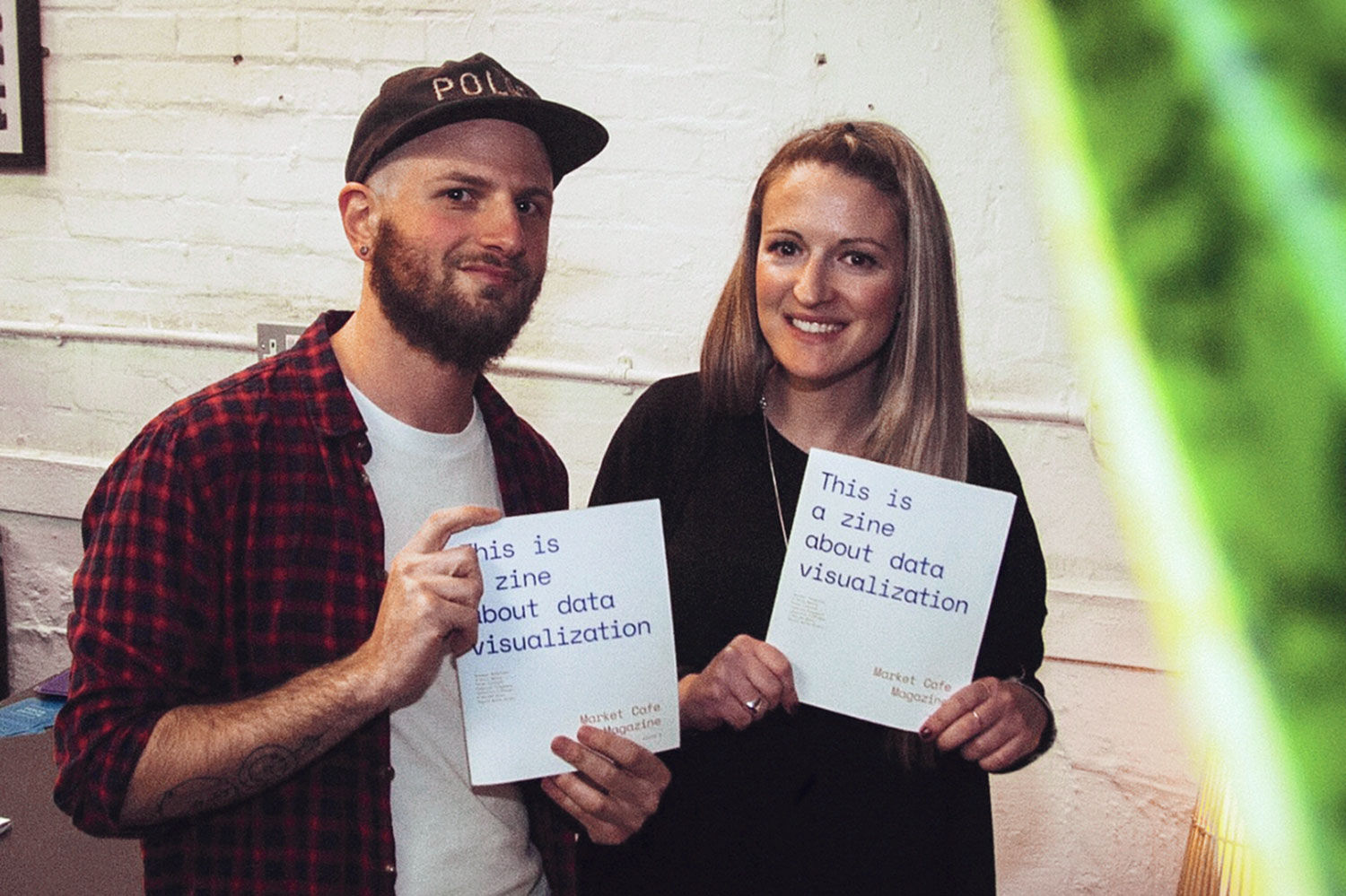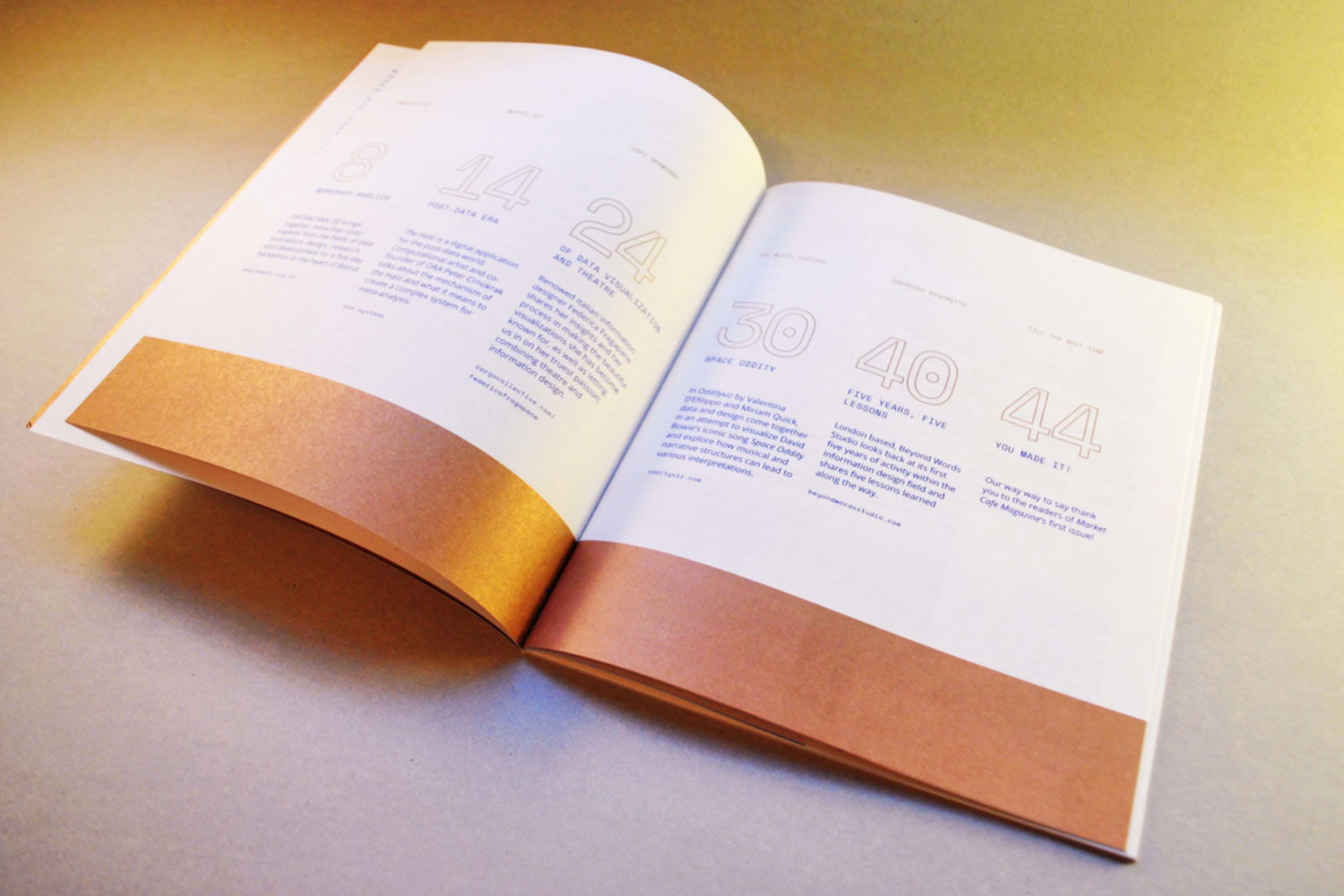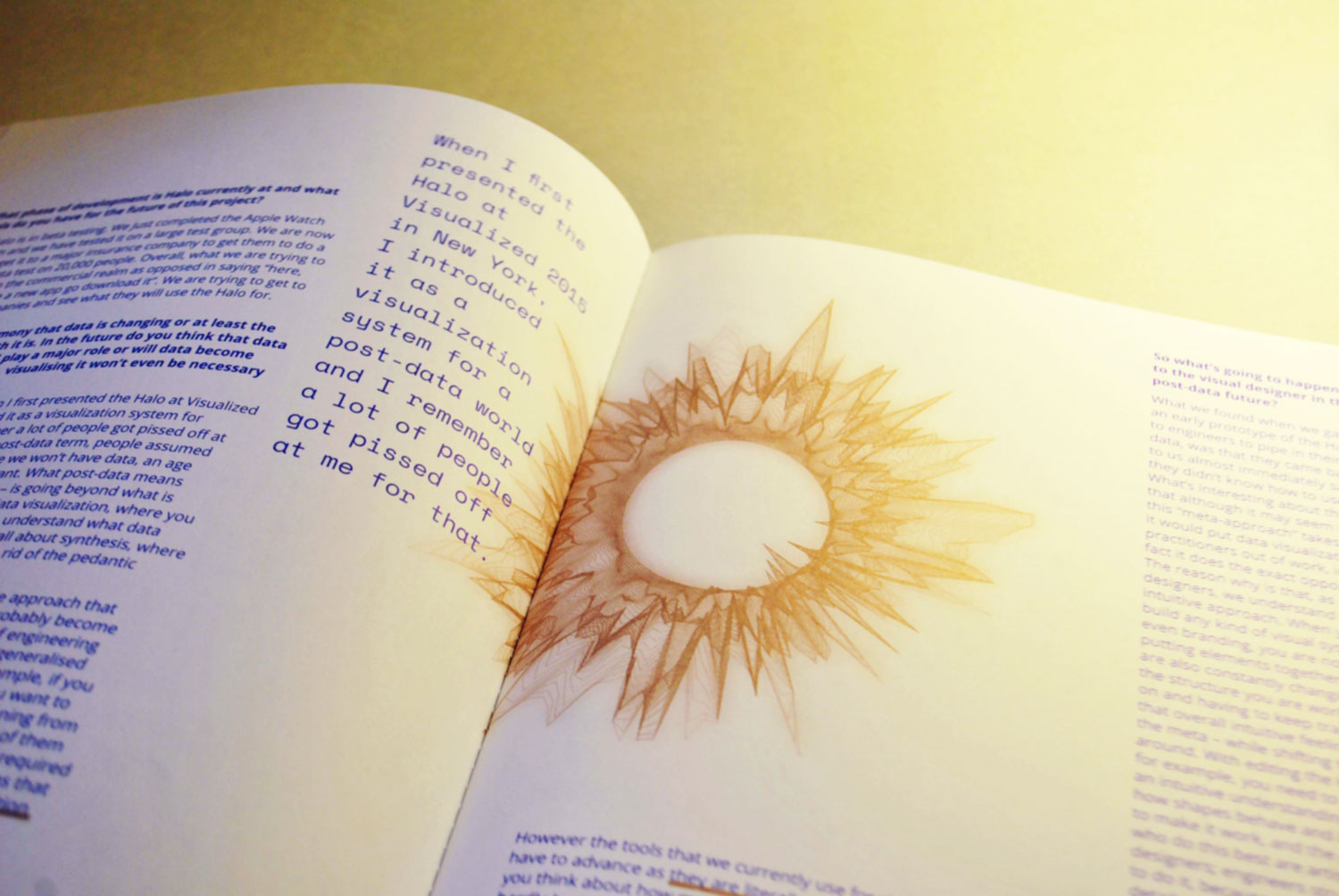Market Cafe Magazine, a new zine about the magical world of data visualization
Piero came to London for a master course at London College for Communication. After his study he did an internship that turned into a freelance job which turned into ten years of working in London as a graphic designer. Piero met Tiziana when he started working at Information is Beautiful Studio now Beyond Words, about two years ago. After her master at Politecnico di Milano, Tiziana wanted to work abroad. She decided to give herself a couple of months to go somewhere and find a job, which happened to be in London at Information is Beautiful Studio. And that has been 3 years ago now.

Can you, for the people who have not yet seen the magazine, give a quick overview of what Market Cafe magazine is all about?
Piero: It's a small publication, it's about 18 by 22 cm, a little bit bigger than A5, but with a slightly square like format. It's designed to be printed in only 2 colours, so it has a very restrictive colour pallet. It has a very particular look and feel. The typography, layout and grid are all very, not strange, but paired back. Because the magazine wants is to lift and highlight the work of the contributors. The content consists of project overviews and interviews with designers and artists. We try to put out interesting questions, and things that we as designers ourselves would like to know from them. But mostly we let them do the talking and give them space. Some features are not necessarily interviews but, short articles or little essays.
Tiziana: You might have noticed that we sometimes refer to the magazine as ‘magazine’ and sometimes as 'zine'. This because the idea is that Market Cafe Magazine is something between a proper magazine and a fanzine. We really loved the idea of a fanzine and the idea to produce something that is not totally polished, a product that keeps its rough shape, but with amazing content.
So it’s a fanzine about creating data visualizations?
Piero: We are the fans! We want to share this passion about being curious on the field of data visualisation which has now grown so big that it includes sub genres such as information design, data art. We want to talk about it in many different issues so that we can experiment how we tailor the content by cherry picking the people we want to talk to. It feels friendly and it doesn't seem too formal but it also wants to be a bit rough and intimate and keep its target audience close. We are immersive in this community and maybe that's because of London, but we try to not just focus on the community in London. In fact issue one has a lot of contributors that don't live in London.
Tiziana: It's a way to reach out and learn who is behind the visualisation works? We want to reach this people and just to have a nice chat, an honest conversation, nothing too formal or too serious.
Piero: For example if you were in Milan, for Visualized. You had the opportunity to listen to Valentina D’Efilippo talk about Space Oddity. If you were in London you could have listened to her with Mariam Quick speaking about the project as well. But the idea is that if you weren't able to attend these events, you still can read about the project and the whole process behind it through the magazine. And of course you can read about it in a blog for example. But we want to make sure that the 'zine' is where things happen and also make it collectable and archivable. The idea is to have a physical collection of amazing projects we're passionate about. Give the designers a chance to expand on and talk more deeply about how this project came to be.
We're interested in many forms of content. Not only data visualization projects but also in events and workshops. But also in the life and activities of established studios that we think make good work so there is room for all of that.
Tiziana: There is room for stories, experiences, and everything that is related to a dataviz piece. We can also talk about creative process or how they work in general, without mentioning an individual piece.

Can you tell us about how the project started?
Piero: I think there is an important factor that allowed this project to begin. Which was the fact that we stopped working together. When we were colleagues we were so into the daily life of the studio, it was so easy to catch-up because we were sitting back to back. We started to have regular catch-ups. Like once a month, we talked about how life at the studio is, or ask if the other had heard about a certain event that happened. We had 3 or 4 of these catch-ups before coming up with the idea of starting 'zine'. It was more of a hybrid between when we stopped working together and started to work together again.
Tiziana: We decided to go for the ‘tricky’ path. We thought let's do a physical product. Let's spend time and energy making a printed product. At the end the result gives you a big satisfaction. I have mainly worked on digital projects. So for me doing a print project was a big challenge. It was a learning curve. We met a lot of interesting and talented people and friends who helped us – and it turned out to be really fun!
Was the restriction of the 2 colors that you set for yourself an extra difficulty?
Piero: The colours were and are definitely a restriction. It made things complicated in the beginning. Because first it's not just a technical restriction. It's the obvious boundary of translating all these amazing pieces of work, that come in many different colours, into an almost grayscale image. But even that would have been easier! Since we chose two colours we risk giving different meanings to the pieces we cover. Our main concern was how we could make it in a way that would still make our contributors happy to share these pieces. This was something we knew would be a restriction. We knew that we had to tackle it carefully. But that's what we wanted because we didn't just want to make CMYK informational magazine. It’s not about that. We wanted to make something we like and something we have fun making since the beginning.
Who came up with the name, Market Cafe Magazine? And where does it stand for?
Piero: We had a couple of things in mind for the name. The first thing which was an absolute must was: the name shouldn't have the word 'dataviz’, ‘infoviz’ or 'data'. It has to be something else. Because we are not making a newspaper on information design or something you can find on a blog or by googling the right words. The two words that pick your curiosity are probably 'market' and 'cafe'. When you read the magazine there are so many references to having coffee. Maybe it's because we are Italian and we have a strong connection with coffee. It's not just about the taste, it's about what it represents. Like when you go meet a friend you haven't seen in a while you don't tell them let's go have a beer in Italy you tell them let's go have a coffee. Coffee stands for a conversation, it's stands for a moment where you share things and that's exactly what we think the 'zine' wants to do. We are all designers from different ages, different parts of life but there is this environment you can be casual with each other, it's like taking away all the unnecessary 'crap'. Let's share what we can learn from each other in front of a coffee, that was our idea. Then the market was something we could relate to. We live in London and it's full of street markets where cool things happen so that's where these two words come from.
You launched the magazine during Visualized in Milan, how did that happen?
Piero: We didn't know for sure that was going to be a deadline we could match. I think at the beginning we set ourselves the goal of making this 'zine'. We were excited about it, we didn't know if it was going to be achievable in that time. Because I was also involved in organizing Visualized I could tell these things were going in the same direction and thought 'maybe we could do it'. Things spiked up in terms of productivity towards the last two months I would say, especially the last month before Visualized. The process is hard to define but I think we've got an idea. The first issue being the creation, before issue one we had nothing. Issue two is now going to be easier in some ways. We are going to set ourselves new challenges as well. We had an early structure of how we wanted the magazine to be. But we didn't know if the people we wanted for our content would like our work. We had to have plan B's for everyone. So first we contacted the people we wanted in the 'zine' and as soon as they said yes we started drafting interviews. For designers we thought the design would be the most challenging part. I think we learned that it's not, it's the actual text content and there is a lot of it. To cut that text down into what we now have was even more work. I would like to share another aspect that I thought was cool about this all. That is that 90% of these interviews were done by email and one we managed to do face to face with a coffee and I love that. In an ideal world I think that's how we should do it, all the time, but it takes a lot longer. You have to go there with a recording device, then you have to transcribe everything and it takes a long time. I think in a semi ideal world it's still 80/90% by email and then one or two big pieces where we meet the person. So much more content comes out and we hear stuff that isn't found anywhere else and I think that's really interesting.
Can you tell about the design process leading up to the first edition?
Tiziana: It's been a learning by doing experience! Everything happened quite fast. We decided how to go about this 'zine', how to distribute the content, etc... and that was the most time consuming part. The actual ‘making’ part of it, on the other hand was very fast. We had a deadline to meet and we worked very hard to match it.
What have you learned so far from the project? Or is there something that positively surprised you?
Tiziana: Creating content, was fun but also a lot of work. I worked on the 'zine' in my spare time. Piero and I spent nights and weekends working on it. This made everything even more challenging! Meetings after dinner or doing Skype calls and working late nights on it... I think we need something different once in a while and it's nice to have a second project to do in your spare time.
Piero: I completely agree with what Tiziana said. I think additionally it's also the fact that we are not a magazine that talks about clothing, but about the field we're passionate about. It gives us the chance to meet people that we wanted to ask questions to and talk to. I'm not sure if we would have had that chance if we didn't start this project. Obviously that's one of the biggest rewards, because we are learning from these guys through what they share with us. We are the first ones to hear about it and the fact that we have to spend so much time condensing the content or change something so it fits the style of the magazine without changing anything of the message they were meaning to tell us. It forces us to look really closely at their stories. I often pick up a magazine and just skim through and might miss something. Well we're taking this into account and picking word by word carefully. Which means that we know the stories of these contributors quite well. It helped us learn a lot.
Tiziana: It was also a discovery, when we selected the people. We knew a bit about their professional background, but after you read the interviews you might discover something unexpected and realise that is more interesting that you initially thought. So it was a revelation all way through.
Is your way of looking at your own work changed because of the interviews and making the zine?
Tiziana: I would say that my opinion on data visualization has expanded a lot. In the 'zine' we've got works about data, music, theatre, etc. It makes data even more interesting, Maybe more human, tangible or concrete.
Lastly, when will the next issue be published and how many can we expect?
Tiziana: We are planning to publish 3 issues a year in 2017, so the second issue will be out in July and the third one around November.
The first issue of Market Cafe Magazine is available at their online shop and in selected shops around the UK and Italy. The copies are numberd.




